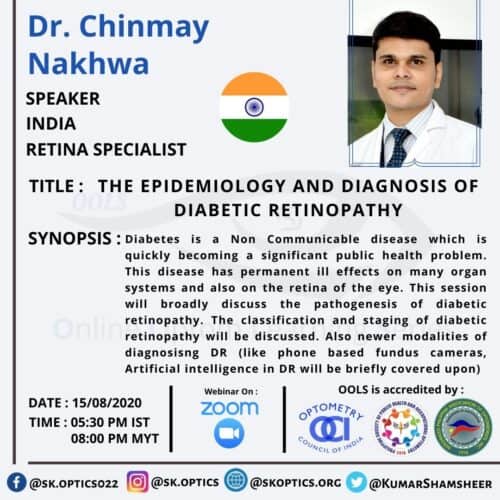
Dr. Chinmay Nakhwa, a practicing retinal surgeon, begins with an overview of diabetes and its effects on the retina. He warns us about the growing epidemic of diabetes and the ophthalmic problems related to diabetes. He briefly mentions the risk factors for diabetic retinopathy, enlisted below
- Duration of diabetes
- Glycemic control
- Hypertension
- Dyslipidemia
- Pregnancy
- Nephropathy
Dr. Nakhwa specifies the ocular implication of diabetes, which includes cataracts, DR, and diabetic macular edema (DME). He walks us through the stages of DR and explains the use of angiography for diagnosis. We learn the importance and urgency of treating proliferative DR. The following stages were covered in detail
- Non-proliferative diabetic retinopathy (NPDR)
- Proliferative diabetic retinopathy (PDR)
- Clinically significant macular edema (CSME)
- Advanced diabetic eye disease
As practitioners, Dr. Nakhwa recommends that we perform adequate retinal screening to catch the at-risk patient before functional vision loss occurs. Early screening can prevent vision loss, and sometimes vision loss may also be reversed if treatment is received early. He talks about how optometrist can screen for diabetes using different cameras. Following is a list of all the different types of cameras that are now available
- Table-top cameras
- Non-mydriatic cameras
- Handheld cameras
- Smart phone-based cameras
Lastly, we understand in brief the different forms of treatment for DR. Primarily, the use of different types of laser treatments and when each type is used clinically. He mentions that the current mainstay of treatments is Anti-VEGF injections, and we discuss the pros and cons.
We learn the most advanced treatment options. The last form of treatment is surgery, and the different reasons for undergoing surgery are enlisted. We also see a video of vitrectomy in action to understand the process better. This session is followed by an interesting Q and A session with the live audience.
References
Websites
International Diabetes Federation
https://www.idf.org/aboutdiabetes/what-is-diabetes/facts-figures.html
Editorials
Hossain P, Kawar B, El Nahas M. Obesity and diabetes in the developing world–a growing challenge [published correction appears in N Engl J Med. 2007
https://pubmed.ncbi.nlm.nih.gov/17229948/
Papers
Klein R, Davis MD, Moss SE, Klein BE, DeMets DL. The Wisconsin Epidemiologic Study of Diabetic Retinopathy. A comparison of retinopathy in younger and older onset diabetic persons. Adv Exp Med Biol. 1985
https://pubmed.ncbi.nlm.nih.gov/4036719/
Stratton IM, Adler AI, Neil HA, et al. Association of glycaemia with macrovascular and microvascular complications of type 2 diabetes (UKPDS 35): prospective observational study. BMJ. 2000;321(7258):405-412.
https://pubmed.ncbi.nlm.nih.gov/10938048/
Klein R, Klein BE, Moss SE, Cruickshanks KJ. The Wisconsin Epidemiologic Study of Diabetic Retinopathy: XVII. The 14-year incidence and progression of diabetic retinopathy and associated risk factors in type 1 diabetes. Ophthalmology. 1998;105(10):1801-1815.
https://pubmed.ncbi.nlm.nih.gov/9787347/
Diabetes Control and Complications Trial Research Group. Effect of pregnancy on microvascular complications in the diabetes control and complications trial. The Diabetes Control and Complications Trial Research Group. Diabetes Care. 2000;23(8):1084-1091.
https://pubmed.ncbi.nlm.nih.gov/10937502/
Mohan V, Meera R, Premalatha G, Deepa R, Miranda P, Rema M. Frequency of proteinuria in type 2 diabetes mellitus seen at a diabetes centre in southern India. Postgrad Med J. 2000;76(899):569-573.
https://pubmed.ncbi.nlm.nih.gov/10964123/
Smart phone based camera
Remidio
